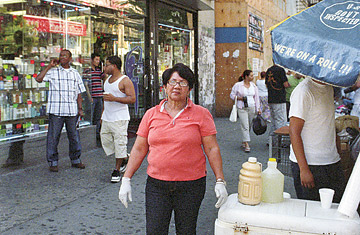
A loan from Grameen America allows Altagracia Familia to buy ingredients for the empanadas and sweets she sells from her cart.
Emily Medina isn't running a pyramid scheme, despite what people often think. As the petite 26-year-old works her way through some of New York City's poorer neighborhoods, she approaches women selling food and trinkets on the street and offers to lend them money to grow their businesses. The organization Medina works for, Grameen, is one of the world's largest microfinance outfits and has a Nobel Prize to its name for this work. But in New York neighborhoods where loans to street vendors tend to come with interest rates north of 40%, it can take a while to build trust. "I didn't believe it until I had the $1,500 check in my hand," says jewelry seller Rosa Lopez.
Thirty years ago Muhammad Yunus, the founder of the Grameen franchise, started lending small sums to poor entrepreneurs in Bangladesh to help them grow from a subsistence living to a livelihood. His great discovery was that even with few assets, these entrepreneurs repaid on time. Grameen and microfinance have since become financial staples of the developing world, but by coming to the U.S. Grameen is taking on a different sort of challenge: one of the planet's richest countries. Yes, money may be tight in the waning recession, but this is still a nation of 100,000 bank branches.
Yet Yunus believes that in just a few years Grameen America will be so successful that it turns a profit, thanks to 9 million U.S. households untouched by mainstream banks and another 21 million using the likes of payday loans and pawnshops for financing. Profit has long eluded U.S. microfinanciers. "If it's not profitable, it's not microlending — it's charity," Yunus said on a recent trip to the U.S. The question, then, is whether there is a role for a Third World lender in the world's largest economy.
Here is how Grameen is trying to establish one: on a Thursday afternoon, Medina and 10 borrowers gather in Ziomara Suarez's apartment in the northern prong of Manhattan. As the borrowers — all women, all immigrants — pack into a room with shelves full of the herbal health remedies Suarez sells, they each hand Medina a small blue ledger with a loan payment tucked inside. If any one of the women doesn't pay her weekly installment, credit will be cut off to the entire group — stunting the small businesses they've each developed. Collateral and credit scores may be missing, but peer pressure is powerful. The result: a 99% repayment rate in the U.S.
Since 2008 Grameen has collected 1,700 borrowers in New York City, and last June it opened a second branch in Omaha, Neb. Other cities in its sights include San Francisco, Boston and Charlotte, N.C. — anywhere local businesspeople raise seed capital and a bank will host low-cost savings accounts for borrowers with just a few dollars, since savings are a key part of the Grameen philosophy. "There are whole populations that aren't being reached by the banking sector," says Bob Annibale, director of microfinance at Citibank, which partners with Grameen in New York. Like other financial giants, Citi sees a lucrative new market in the unbanked. But attracting those customers isn't easy, and Citi is overjoyed to have Grameen deliver them.
That was also true when Grameen first came to the U.S., in the late 1980s, and tripped up. Under Grameen's tutelage, Southern Bancorp started making microloans to entrepreneurs in Arkansas. At first, the loss rate was a shocking 30%. Even after getting that under control, Southern found that what people really needed wasn't seed capital but broader help developing work skills and finding jobs.
The folks running Grameen America say that this time around results will be different because Grameen employees themselves are making the loans, not training an American bank to do it. In New York City, Shah Newaz, who started working for Grameen in 1982, hands out checks to borrowers at Grameen America headquarters — a sparsely furnished one-room office above a laundromat. In Omaha, Habib Chowdhury, who has worked for Grameen since 1985 and is a veteran of its Kosovo start-up, has found more than 250 borrowers since June and has already lent $378,000, mostly to Mexican immigrants stocking up on inventory for small businesses selling things like cosmetics, clothing and Herbalife weight-loss products.
